Have you heard that author Andy Weir has a new book coming out? Very exciting, we know, and according to a syndicated reading list for Summer 2025, it’s called The Last Algorithm, and it’s a tale of a programmer who discovers a dark and dangerous secret about artificial intelligence. If that seems a little out of sync with his usual space-hacking fare such as The Martian and Project Hail Mary, that’s because the book doesn’t exist, and neither do most of the other books on the list.
The list was published in a 64-page supplement that ran in major US newspapers like the Chicago Sun-Times and the Philadelphia Inquirer. The feature listed fifteen must-read books, only five of which exist, and it’s no surprise that AI is to behind the muck-up. Writer Marco Buscaglia took the blame, saying that he used an LLM to produce the list without checking the results. Nobody else in the editorial chain appears to have reviewed the list either, resulting in the hallucination getting published. Readers are understandably upset about this, but for our part, we’re just bummed that Andy doesn’t have a new book coming out.














